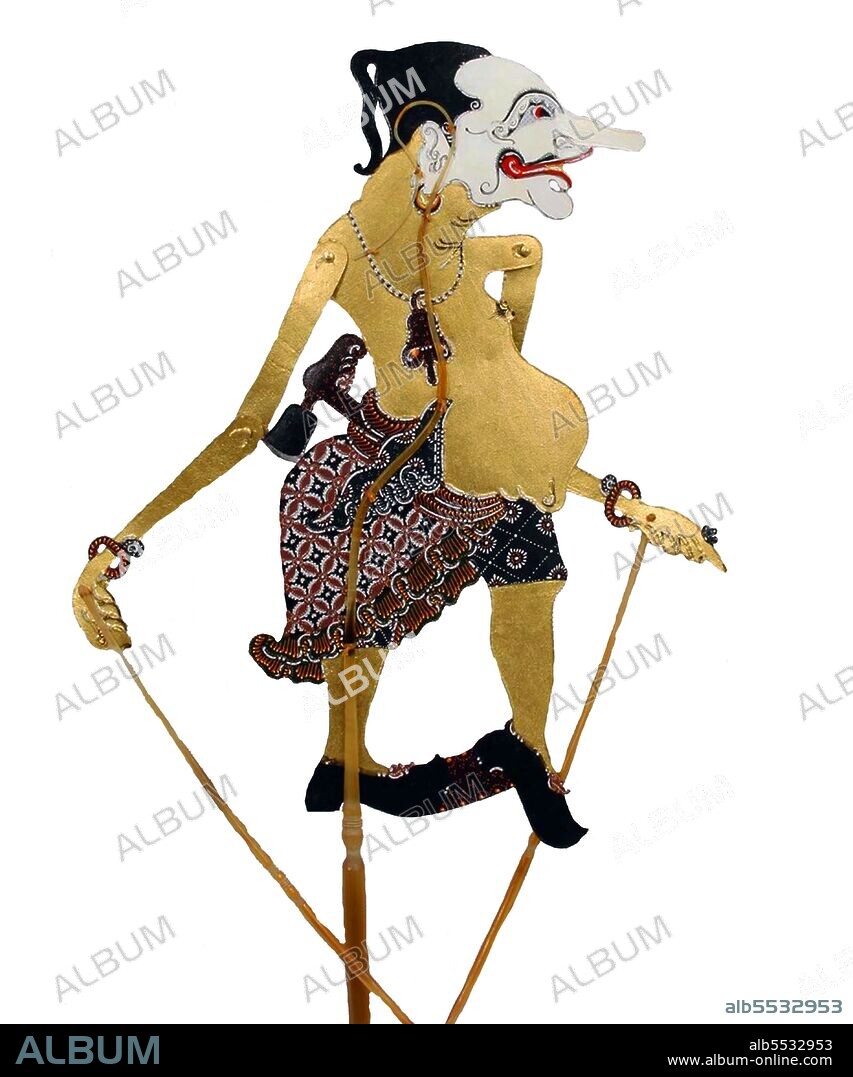alb5532953
Indonesia: Figure of Petruk, wayang kulit ('shadow puppet') character, one of the Punokawan or clown-servants of the heroes.

|
Zu einem anderen Lightbox hinzufügen |
|
Zu einem anderen Lightbox hinzufügen |



Haben Sie bereits ein Konto? Anmelden
Sie haben kein Konto? Registrieren
Dieses Bild kaufen.
Nutzung auswählen:

Titel:
Indonesia: Figure of Petruk, wayang kulit ('shadow puppet') character, one of the Punokawan or clown-servants of the heroes.
Untertitel:
Automatische Übersetzung: Im javanischen Wayang (Schattenpuppen) sind die Panakawan oder Panakavan (Phanakavhan) die Clown-Diener des Helden. Es gibt vier von ihnen – Semar (auch bekannt als Ki Lurah Semar), Petruk, Gareng und Bagong. Semar ist die Personifizierung einer Gottheit, von der manchmal gesagt wird, sie sei der Dhanyang oder Schutzgeist der Insel Java. In der javanischen Mythologie können sich Gottheiten nur als hässliche oder anderweitig unansehnliche Menschen manifestieren, und so wird Semar immer als klein und dick mit einer Stupsnase und einem baumelnden Leistenbruch dargestellt. Seine drei Gefährten sind seine Adoptivsöhne, die Semar von ihren Eltern als Verehrer gegeben wurden. Petruk wird als groß und schlaksig mit einer langen Nase dargestellt, Gareng als klein mit einem Klumpfuß und Bagong als fettleibig. Wayang ist ein javanisches Wort für bestimmte Arten von Theater (wörtlich „Schatten“). Wenn der Begriff für verschiedene Arten von Puppentheater verwendet wird, wird manchmal auch die Puppe selbst als Wayang bezeichnet. Aufführungen von Schattenpuppentheater werden auf Java von Gamelan begleitet. Die UNESCO hat Wayang Kulit, ein Schattenpuppentheater und das bekannteste der indonesischen Wayang, am 7. November 2003 zum Meisterwerk des mündlichen und immateriellen Erbes der Menschheit erklärt.
In Javanese wayang (shadow puppets), the panakawan or panakavan (phanakavhan) are the clown servants of the hero. There are four of them – Semar (also known as Ki Lurah Semar), Petruk, Gareng and Bagong. Semar is the personification of a deity, sometimes said to the be the dhanyang or guardian spirit of the island of Java. In Javanese mythology, deities can only manifest themselves as ugly or otherwise unprepossessing humans, and so Semar is always portrayed as short and fat with a pug nose and a dangling hernia. His three companions are his adopted sons, given to Semar as votaries by their parents. Petruk is portrayed as tall and gangling with a long nose, Gareng as short with a club foot and Bagong as obese. Wayang is a Javanese word for particular kinds of theatre (literally 'shadow'). When the term is used to refer to kinds of puppet theatre, sometimes the puppet itself is referred to as wayang. Performances of shadow puppet theatre are accompanied by gamelan in Java. UNESCO designated Wayang Kulit, a shadow puppet theatre and the best known of the Indonesian wayang, as a Masterpiece of Oral and Intangible Heritage of Humanity on 7 November 2003.
Bildnachweis:
Album / Pictures from History/Universal Images Group
Freigaben (Releases):
Bildgröße:
3800 x 4560 px | 49.6 MB
Druckgröße:
32.2 x 38.6 cm | 12.7 x 15.2 in (300 dpi)
Schlüsselwörter:
ASIEN • ASIEN, KONTINENT • GEMAELDE • GESCHICHTE • GOETTER • GOTT • GUIGNOL • HANDPUPPE • HANDPUPPENTHEATER • HANSWURST • HINDU • HINDUISMUS • ISLAM • KASPERLETHEATER • KONTINENT, ASIEN • KUENSTLER • KUNST • KÜNSTLER • MALEREI • MARIONETTE • MODE • MOHAMMEDANERIN • MOSLEMIN • MUSLIMIN • PUNCH AND JUDY • PUPPENTHEATER • RELIGION • STIL • THEATER: PUPPENTHEATER • UNTERHALTUNG (ENTERTAINMENT) • UNTERHALTUNG • VOLKSKUNST: INDONESISCH • ZEITGESCHICHTE • ZEITVERTREIB


 Pinterest
Pinterest Twitter
Twitter Facebook
Facebook Link kopieren
Link kopieren Email
Email
